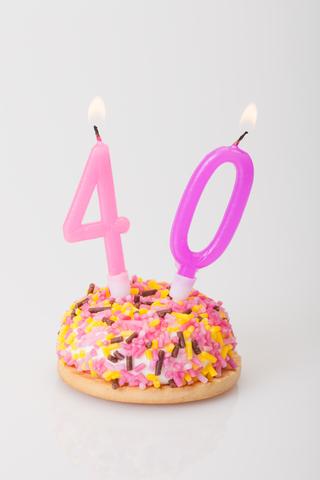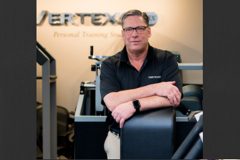Weight Loss After 40 – Why It’s So Hard and What Works
If you’re like many women over 40, you’ve probably noticed that it’s become a lot easier to gain a few pounds than to lose them. The foods that you ate without care in your 20s and 30s now stick to your body like glue, adding bulk to your midsection. The good news: The solution to a slim, firm body at 40-plus is no farther than your fridge. Research shows that, when combined with a little regular exercise, what you eat and when you eat it are your metabolic secret weapons for building muscle mass, the body’s prime calorie-burning tissue and a key driver of your metabolism and weight loss.
The main culprit that slows metabolism and often leads to yo-yo dieting is what I call shrinking muscle syndrome. Starting at age 30, most people begin to lose about half a pound of the metabolism-revving tissue each year. Poof! Gone, just like that. And at age 50, the rate doubles. The average sedentary woman may have lost nearly 15 pounds of muscle by the time she reaches her late 50s, a change that could cause her to gain nearly the same amount in body fat.
But too-tight jeans, a puffy midsection, and an increased risk of diabetes don’t have to be your future. (Your chances of winding up with all of the above increase with each pound of muscle you lose.) Here are some helpful tips and perspectives I have accumulated from my years of clinical nutrition practice and from being almost 40 myself.
Muscle Up
Increasing muscle density is super important to weight loss after 40. Muscle is active tissue and the more of it you have the faster your metabolism is. As we age, women really need to work to maintain muscle mass. Our hormones are changing and we usually become more sedentary. Both of these issues encourage lower muscle density and a slower metabolism. Once we hit menopause we really have to work at maintaining muscle. Do yourself a favor and start resistance training now. Not only does resistance training improve muscle density it can also help preserve bone density, improve joint function and health, and correct posture imbalances.
When you do resistance training, it causes a degree of microtrauma, or tiny tears, to the muscle tissue. Over the next 48 to 72 hours, your body remodels and heals that tissue with amino acids, making it stronger—or, if you’re just starting out and need to gain muscle mass, the muscle slowly grows. This throws coals onto your metabolism’s calorie-burning fire in two ways: First, the more muscle you build, the more calories you’ll burn each day. Second, the rebuilding process itself requires extra energy, boosting your daily calorie burn by 5 to 9%.
The great news: You don’t have to spend hours in the weight room. Research shows that you’ll have the same muscle gains with 2 days of strength training as you’d have with 3.
Keep Tabs On Protein
You already know to keep calories and fat in check, but you’ll fan the flames of your metabolism by putting another nutrient on your radar: protein, the building block of lean muscle mass. Each time you eat a protein-rich food—say, a piece of fish or cheese—your body goes to work, breaking it down into smaller particles called amino acids. The amino acids enter your bloodstream and are then absorbed by your muscle tissues and other cells. Once the amino acids end up in your muscles, your body starts putting them back together—sort of like Legos—into your muscle tissue. This is called muscle-protein synthesis, and it’s the process your body uses to build and maintain muscle mass.
Research shows that some women begin skimping on the muscle-sustaining nutrient as they age, consuming less than the RDA. Calorie-conscious dieters also tend to cut back on protein, when they should be doing the opposite. Not only does losing muscle make your clothing fit poorly, but you begin to burn fewer calories, so even if you’re eating the same amount, you can easily regain the weight you shed. Having less muscle mass also makes you weaker, making it harder to do simple activities, so you become more inclined to crash on the couch. Eventually, the scale climbs back up and you start all over again, chipping away at muscle mass and putting the chill on your metabolism with each diet you try. Aim for 20 to 30 g of protein at each meal.
Focus More On Self-care and Less On Counting Calories
Hopefully after 40 eating will take on a whole new perspective. What we eat has the power to help prevent disease and increase vitality. Healthy eating habits can reduce your risks of heart disease, cancer, diabetes, and autoimmune diseases. Focusing on improving your health and vitality is an empowering place to focus your energy. To do this chose nutrient rich whole foods that support and nurture your health and vitality.
Sleep At Least 7 Hours a Night
Getting enough sleep is critical to weight loss success. When we reach our 40’s our lives tend to be very busy and stressful. Too many people sacrifice sleep to try and keep up with the demands. If you are not sleeping well, fatigue and hormone imbalances will increase your hunger. People that consistently sleep 5 hours or less a night are 15% more likely to become obese. Getting enough sleep is not only a great strategy for weight loss it will benefit your health and mental wellbeing as well.
Watch Your Carbs
After 40 the changes most women experience hormonally make us more susceptible to weight gain if our blood sugar is elevated. Eating fewer refined carbohydrates will help reduce blood sugar spikes and promote a metabolism that can support weight loss. Balance your meals with healthy lean protein sources, vegetables, and healthy whole food complex carbohydrate sources such as; whole grains (brown rice, buckwheat, freekeh), quinoa, wild rice, sweet potatoes, and beans.
Have Your Thyroid Checked Regularly
Along with hormonal changes, many lifestyle factors that play into the health and functioning of your thyroid gland can start to catch up with you when you reach your 40’s. Your thyroid is responsible for managing many important metabolic processes in your body. If it is not functioning well losing weight can be very difficult. Having your doctor run tests to check your thyroid hormone levels is a great proactive step in maintaining your health and vitality.
Embrace The Body You Have Now
Your body has changed. Not just on the outside but on the inside as well. Your hormones, muscle density, and metabolism have changed. It is supposed to. It is a beautiful and purposeful process. It is important to understand that it is going to be different from the body you had in your 20’s. Losing weight may take more time. Understanding this and embracing it is important. We need to appreciate the bodies we have.
Our bodies have undergone some amazing and beautiful life changing journeys. Embrace this, there is so much power and strength in what our bodies have done. Nurture the body you have with healthy whole food, consistent sleep, and exercise. You will be amazed with how much better you feel and look.
“Weight Loss After 40 – Why It’s So Hard and What Works”, Written for Vertex Fitness Personal Training Studio by Ashvini Mashru, RD
Request a complimentary first session at Vertex Fitness, Voted the BEST Personal Training Studio on the Main Line
Click HERE and we will schedule a session to try it yourself
Complimentary First Workout Session








Leave a Comment